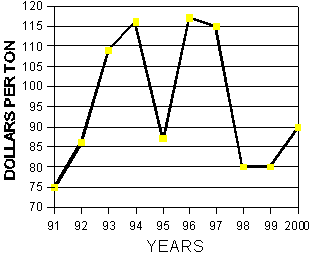Alfalfa Report
Yuma County, Arizona
November 6, 2000
Yuma County Office
2200 W. 28th Street, Ste. 102
Yuma, AZ 85364
(520) 726-3904
(520) 726-8472 FAX
Production Update:
PDF version, KB
Fall Dormancy: Fall dormancy refers to the growth of alfalfa during the fall. Shortening day-length and declining temperatures in the fall cause differences in growth among alfalfa cultivars not seen at other times of the year. Fall dormant cultivars have short, prostrate growth compared to tall, erect growth of nondormant cultivars. Fall dormancy signals the beginning of the hardening process where the plant stores carbohydrates for the oncoming winter. Fall dormancy is related to winter hardiness, although other factors influence winter survival as well. Due to our mild winters, fall dormancy is an undesirable characteristic for alfalfa in the lower elevation areas of Arizona. In fact, plant breeders have been developing cultivars for mild winter areas that are nondormant in the fall and have increased winter growth ever since the introduction of Hairy Peruvian alfalfa in 1899. Winter survival in the lower elevations in Arizona is influenced more by cutting management and pests than by low temperature.
Insect Management: Sowbugs can damage alfalfa stands by feeding on seedlings in reseeded fields. Sowbugs are crustaceans not insects. Alfalfa seed fields that have been dry for six to eight weeks usually have more of a problem, especially if the field has received one or more inches of rain prior to renovation. Sowbugs will eat seedling alfalfa to the ground line. Feeding on leaves of older plants rarely cause economic damage. Monitor sowbug activity in alfalfa fields at night, after 9 p.m. Feeding damage commonly spreads out from field borders. Sowbugs may be found along field borders in the daytime hiding under litter. Carbaryl (SevinŽ) 5% bait may be applied broadcast at 30 lb/acre when sowbug densities are high enough to cause sever loss of seedling alfalfa stands.
Weed Control: Annual bluegrass (Poa annua) can be controlled with
preemergent applications of Trifluralin granules and early postemergent
applications of Select. Poast will not control this weed which begins
to germinate in October and continues to germinate until April.
| Market Summary |
High
|
Low
|
Average
|
Off grade
|
| Past 2 Weeks (Oct. 24 to Nov. 6, 2000) |
100
|
85
|
90
|
70-85
|
| Last Year (Oct. 24 to Nov. 6, 1999) |
85
|
70
|
80
|
60-70
|
10 Year Summary (October 24, to November 6, 1991-2000):

Issued in furtherance of Cooperative Extension work, acts of May 8 and June 30, 1914, in cooperation with the U.S. Department of Agriculture, James A. Christenson, Director Cooperative Extension, College of Agriculture and Life Sciences, The University of Arizona.
The University of Arizona is an equal opportunity, affirmative action institution. The University does not discriminate on the basis of race, color, religion, sex, national origin, age, disability, veteran status, or sexual orientation in its programs and activities.
Any products, services, or organizations that are
mentioned, shown, or indirectly implied in this web document do not imply
endorsement by The University of Arizona.
Information provided by:
Barry Tickes, btickes@ag.arizona.edu Extension Agent, Yuma County
Michael Ottman, mottman@ag.arizona.edu Agronomy Specialist
College of Agriculture, The University of Arizona.
Eric Natwick, etnatwick@ucdavis.edu UCCE Imperial County - Farm Advisor
University of California, Davis, CA.
Material written November 6, 2000.
Forages: Crop Mgmt | Soil Mgmt | Irrigation | Alfalfa Reports | Insects | Diseases | Weeds | Pesticides
Home | Other Crops | Forages
For more Arizona Production Ag Information:
Home | Cotton | Veggies| Forages | Grains | Citrus | Crop x Crop | Insects | Diseases| Weeds | Pesticides | News | Weather | Research | Photos | Contacts | General Info. | Site Map
Copyright © 2001 University of Arizona,
College of Agriculture and Life Sciences
Webmaster: Al Fournier (fournier@ag.arizona.edu)